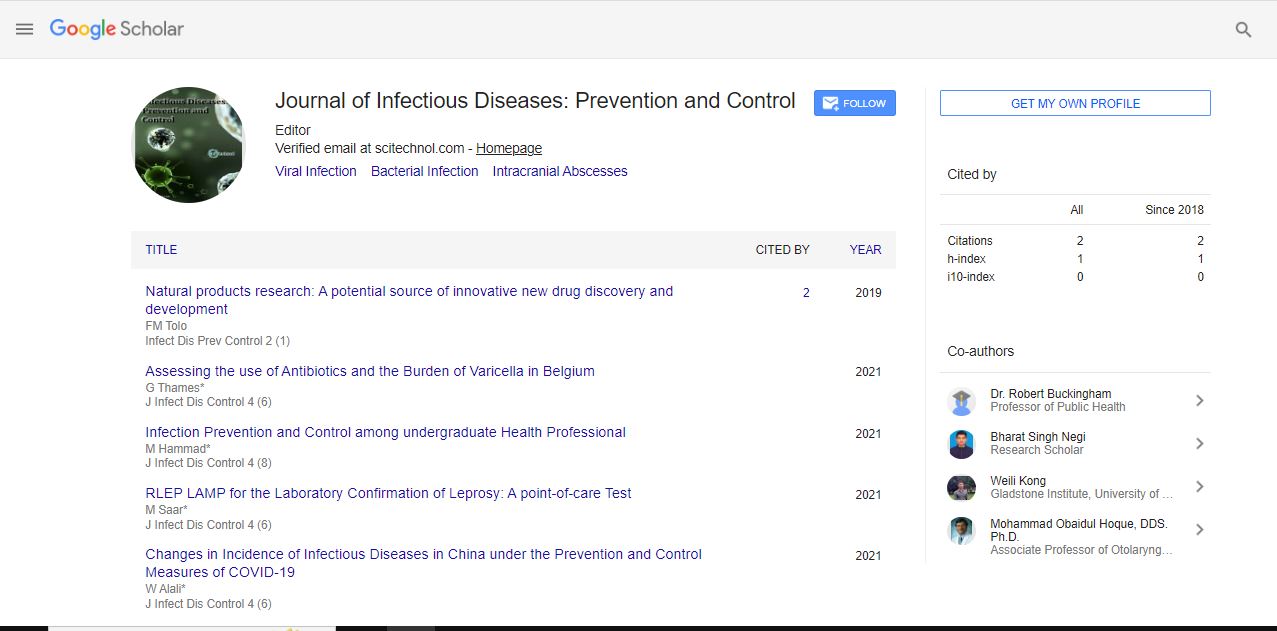Commentary, J Infect Dis Control Vol: 5 Issue: 2
Low and Declining Attack Rates of Imported Typhoid Fever
Patkin smith*
Department of Neurology, Communicable Disease Surveillance Centre (London), London, UK
Corresponding Author: Patkin smith
Department of Neurology, Communicable Disease Surveillance Centre (London), London, UK
E-mail: smith65@gmail.com
Received date: 17-Mar-2022, Manuscript No. IDPC-22-62182;
Editor assigned date: 19-Mar-2022, PreQC No. IDPC-22-62182(PQ);
Reviewed date: 30-Mar-2022, QC No. IDPC-22-62182;
Revised date: 10-Apr-2022, Manuscript No. IDPC-22-62182 (R);
Published date: 17-Apr-2022, DOI: 10.36648/idpc.5.2.117
Citation: smith P (2022) Low and Declining Attack Rates of Imported Typhoid Fever. J Infect Dis Control 5:2.
Keywords: Subclinical and Clinical Infections, Vaccine, Viral Infections
Introduction
The primary motivation behind this study was to decide the hematological varieties in grown-up typhoid patients when contrasted with solid control.Typhoid fever intense and unknown contamination of the reticuloendothelial framework, brought about by Salmonella typhi, and causes significant hepatic inconveniences and biochemical changes. Presently, the indicative test is disengagement of microorganisms from blood, stool, and seldom pee, however serologic tests are still regularly utilized. There is as yet a need to present fast and solid test for typhoid fever. An aggregate of 50 patients and 50 sound people were signed up for this examination, and varieties in hematological variables were considered. Typhoid fever is an overall bacterial contamination set off by a gram-negative bacterium Salmonella intestinal subspecies enterica serotype typhi (Salmonella typhi), and transmittable infection can be moved orally. Hematological boundaries were observed insane in typhoid fever including hemoglobin (low, 10.97 ± 0.88), hematocrit (low, 37.72 ± 1.40), ESR (high 45.08 ± 13.42), platelet count (high 588840 ± 97185), WBCs count (high 38267 ± 22279), neutrophil rate (high, 73.56 ± 9.96), lymphocyte rate (low, 21.24 ± 10.08), and NLCR (high, 5.14 ± 4.00) when contrasted with sound benchmark group. This separating design is not difficult to get by insignificant intrusive methodology and can be utilized for typhoid contamination conclusion.
It is brought about by drinking sullied food and debased water; by the pee or dung of tainted transporter. Whenever an individual is contaminated with typhoid he appears to have fever, stomach torment, relative bradycardia, migraine, and splenomegaly. Old style term of infection is a month and after this length condition begin changing to ordinary. In the principal week intense side effects like pre-eclampsia, clogging and high fever happen, and extreme condition like looseness of the bowels in the subsequent week, and more serious and profoundly consideration acquiring conditions splenomegaly, bonemarrowdiscoveries and a fewdifferent intricacies, for example, hole and gastrointestinal discharge are found in the third week.
Typhoid is a main explanation of horribleness and mortality all through the world, causing a roughly 16.6 million new contaminations and 600,000 passings each year. In Asia nearly passing rate is 80% and in Pakistan dreariness of typhoid is moderately high and necessities general wellbeing mediations. Hot months have higher rate of typhoid, and presently in spite of the fact that occurrence of typhoid fever has been diminishing, however inconsistent episodes keep on happening still. It is assessed that number of new instances of typhoid is around 27 million and it occur with mortality around 200,000 for the most part in South, Central, and Southeast Asia. In typhoid illness transmission is human host-restricted and high peril for sickness is more pervasive in low-and focus pay based countries where typhoid causing Salmonella is endemic, and that have unfortunate disinfection framework, and nonattendance of admittance to safe food and water. The significant approach to spreading this disease is defilement with human feaces and the common vehicle is tarnished water, sustenance, sweets, rough natural items, vegetables, crushes, and contact with debased transporters or patients.
This infection has hatching time of 7 to 14 days and the most transcendent side effect is fever. It is seen that the vast majority of the serotypes of typhoid contaminations are identified absolutely on clinical grounds and treated on the foundation of assumptions. Research facility capacity is restricted in numerous areas where there this infection is endemic and it makes challenging to analyze typhoid fever clinically, as the introduction of this sickness is different and generally like those saw in other febrile ailments. In lab typhoid fever determination requires refinement and afterward ID of Salmonella enterica serotype Typhi. Segregated Salmonella from blood, pee or stool is the most reliable mean of affirming the disease, and the most normalized demonstrative technique is blood culture and it tends to be positive in 60%-80% of the cases. Be that as it may, in our country, patients frequently take anti-microbials prior to continuing for lab examinations, so the microscopic organisms detached from the blood societies is simply 40% to 60% of the typhoid cases. Probability of blood culture energy diminishes with the time being; it is profoundly certain in first week yet afterthat it goeslow sure and becomes negative in the fourth week. Stool culture is similarly a fundamental guide for diagnosing typhoid fever; it very well may be performed to specific when blood culture is negative. Culture of the upper gastrointestinal plot using a duodenal string can be significant yet the method is incapably persevered by energetic youngpeople.
 Spanish
Spanish  Chinese
Chinese  Russian
Russian  German
German  French
French  Japanese
Japanese  Portuguese
Portuguese  Hindi
Hindi 